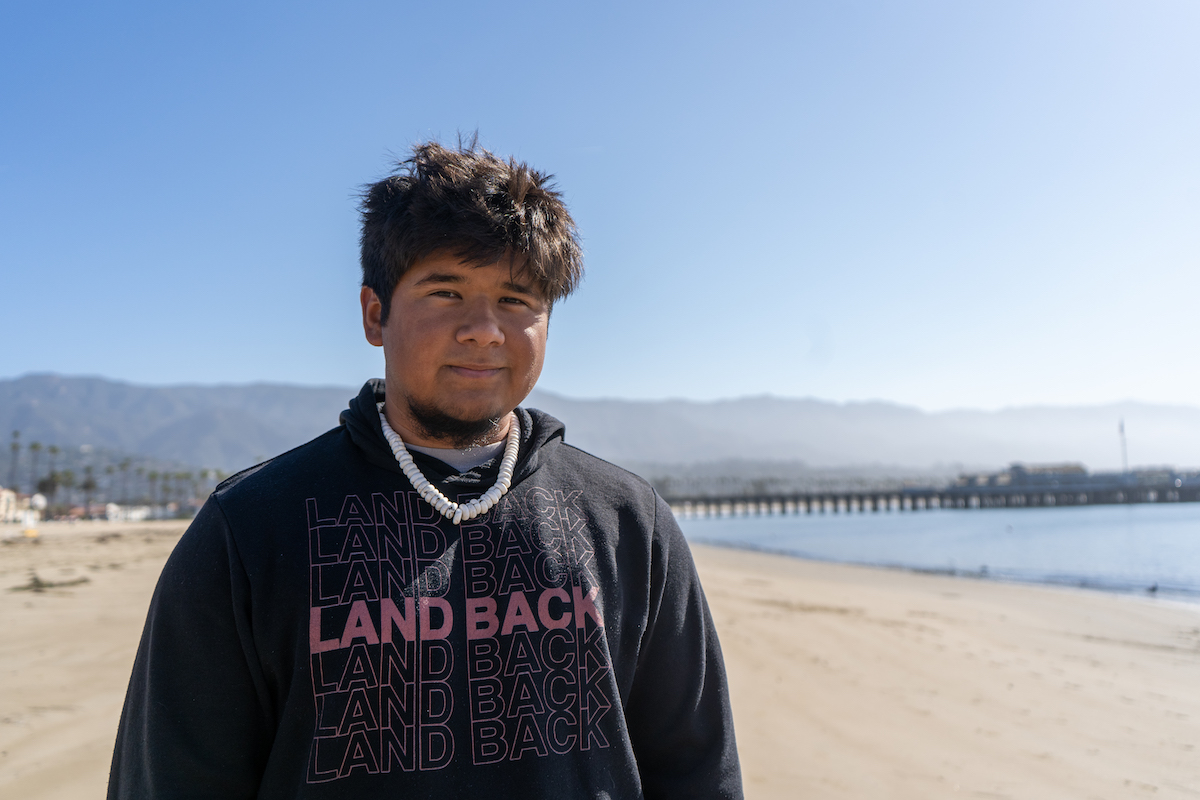Spenser Jaimes Shares Chumash Heritage Through Film
Local Filmmaker Is Researching His Second Documentary Project on the 1824 Mission Revolt

Sitting in the sand at Santa Barbara’s West Beach, on what is originally the Chumash village Syuxtun, 19-year-old filmmaker Spenser Jaimes looks out onto the ocean toward the islands —which he also refers to by their original names: Tuqan (San Miguel), Wi’ma (Santa Rosa), Limuw (Santa Cruz), and ‘Anyapakh (Anacapa) — telling of his family’s roots, and the deeply beautiful culture that has existed along the coast for thousands of years.
Jaimes, whose Šmuwič-Chumash heritage can be traced back to Syuxtun and the island of Limuw, made a splash at the 2022 Santa Barbara International Film Festival with his first-ever short documentary Connected By Water, which documented a traditional paddle out in the channel by relatives from the Coastal Band of the Chumash, Tongva, and Acjachemen tribal nations in redwood-plank tomols.
He has since started Limuw Productions, and is currently researching his next project, which will focus on the 1824 Mission Revolt, which he says is often told through a Spanish or American historical lens.
“Modern ways of storytelling, through books and media, are never done by our own people because we do not have access or the funds to do it ourselves,” he said. “Our people have our own accounts that haven’t been told yet.” He hopes his work can reframe the narrative of the revolt as “childish” and “unorganized,” and instead tell the story of a highly organized response to an act of violence against a young boy.
Growing up with a family that was embedded in local Chumash culture, Jaimes was exposed to a broader historical telling of the Central Coast’s long and complicated history, which changed the entire landscape from a bustling community of villages to a Europeanized settlement in a matter of a couple generations.
He first remembers becoming aware of the discrepancy between historical records and tribal accounts as an elementary school student, when on a field trip to the Museum of Natural History he heard tour guides repeatedly refer to the Chumash ae as a thing of the past.
“Hearing them say Chumash is extinct was rough,” he said, “I came home and told my aunt: ‘They were talking about it in past tense.’”
Later, when the class was assigned its fourth-grade Mission project — which at one time was a staple of public school curriculum in California — Jaimes refused to participate in what he considered a one-sided narrative.
As he grew through high school, he said he had trouble reconciling the fact that he grew up on his own ancestral lands, but much of the City’s historical traditions seemed to reflect only the things that happened after the Spaniards arrived. The easily recognizable white stucco and red-tile roofs that define the “Santa Barbara aesthetic” ignore the fact that natives were forced to work and live in what became a Spanish-occupied area. It’s even more evident, he said, in local celebrations like the week of Fiesta, which paint a pearly-white picture of “Old Spanish Days.”
Sign up for Indy Today to receive fresh news from Independent.com, in your inbox, every morning.
“People need to know the history,” he said. “Celebrating that here is cultural erasure. Ask yourself what you are celebrating. What did they do, and why did they do it?”
Jaimes says he considers himself lucky to have grown up with a family connection to the land, and with aunts and uncles who taught him the traditional songs, practices, and stories. Some people are often separated from their culture, and some may not become involved or aware until much later in their lives.
“My generation, we’ve been lucky enough to be born in a culture,” he said. Along with his relatives, and other indigenous youth throughout the coast, Jaimes has become part of a new generation that is not only socially aware but also politically active. This includes a recent initiative to change the names of the Channel Islands back to their native designations.
One of his newest passion projects is the push for more coastal access for Chumash in Santa Barbara. Since 2001, the local bands of Chumash have revived the thousands-of-years- old tomol crossing from Ventura Harbor to Limuw, and the community regularly launches for weekend trips off the coast. The City charges up to $20 a day for parking, and an additional trailer fee that can add up to over $7,000 per year for the group.
“As the original stewards of our homelands, the Chumash people should not have to pay any amount of money to access our ocean,” he said. “The ocean is where we gather, pray, sing, paddle, and dance together, and where we gather foods and medicines to sustain ourselves.”
He also hopes to have a larger storage space — currently only one tomol can be stored at West Beach at a time — and imagines a day where the channel is once again packed with the native watercraft.
“Access to our ocean shouldn’t just mean free parking. For thousands upon thousands of years our people could fish and travel inside our tomols freely,” he said. “Although on West Beach, having space to house at least one tomol is a step in the right direction, we need an environmentally-friendly non-permanent structure to house our tomols — not just one, but dozens — for any and every Chumash tribe, clan, band and family.”
With easier accessibility to their traditions, he says, Chumash can more easily heal from the traumas brought on by the Spanish missionaries, Mexican and American occupations — “some of which are occurring in real time.”
He is almost at his funding goal of $10,000 for his upcoming project, and is looking to complete the documentary before the 200th anniversary of the revolt in 2024.
Support the Santa Barbara Independent through a long-term or a single contribution.



